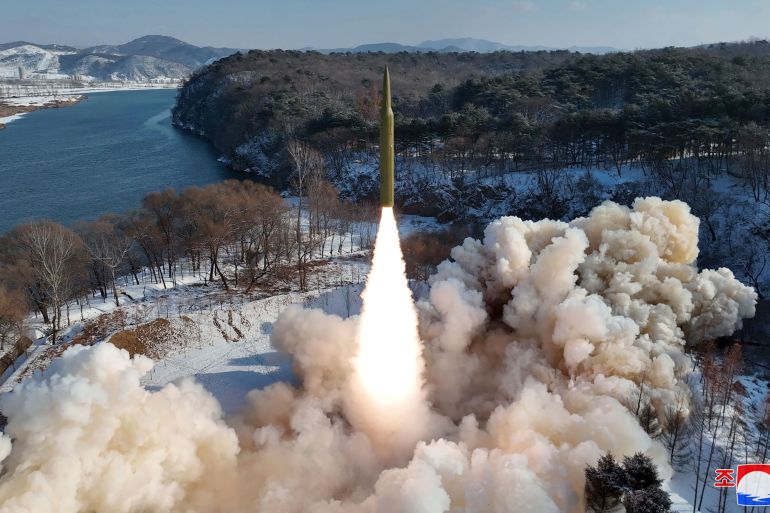North Korea says it tested solid-fuel missile with hypersonic warhead
Latest test ratchets up tensions days after Kim Jong Un designated South Korea as an enemy state.

North Korea said it has tested a new solid-fuel missile fitted with a hypersonic warhead as it continued efforts to develop more powerful, harder-to-detect weaponry.
The launch took place on Sunday afternoon and came as Foreign Minister Choe Son Hui headed to Moscow amid concerns in the United States and elsewhere that Pyongyang was selling weapons to Russia for use in Ukraine in return for Russian technological expertise.
Keep reading
list of 4 itemsUS, Ukraine, dozens more condemn alleged Russia-North Korea arms transfers
North Korea threatens Seoul as tension builds over military drills
North Korea fires artillery towards South’s islands, prompting evacuations
Detected by neighbouring Japan and South Korea, the launch was designed to test the reliability of new multi-stage, high-thrust solid-fuel engines and an intermediate-range hypersonic manoeuvrable controlled warhead, the state-run Korean Central News Agency (KCNA) reported on Monday.
KCNA added that the test-firing “never affected the security of any neighbouring country and had nothing to do with the regional situation”.
The missile flew towards the East Sea, travelling approximately 1,000km (621 miles), Seoul’s Joint Chiefs of Staff said in a statement on Sunday, adding that authorities in Seoul, Washington, DC and Tokyo were analysing the specifications. Japan’s Defence Ministry said its maximum altitude was at least 50km (30 miles).
North Korea’s last missile test was of a Hwasong-18 solid-fuel intercontinental ballistic missile (ICBM), which it fired into the East Sea on December 18.
It previously tested new solid-fuel engines for an intermediate ballistic missile on November 11 and November 14.
Leader Kim Jong Un last week branded Seoul his “principal enemy” and warned he would not hesitate to annihilate South Korea.
“The historic time has come at last when we should define as a state most hostile toward the Democratic People’s Republic of Korea the entity called the Republic of Korea [South Korea],” Kim was reported as saying by KCNA.
Analysts said the timing of the latest test was a concern.
“This launch is more than just a test as it comes immediately after the Kim regime escalated warlike rhetoric toward South Korea and just before North Korea’s foreign minister travels to Russia,” Leif-Eric Easley, a professor at Ewha University in Seoul said in emailed comments.
“Pyongyang’s show of force should be of concern beyond Seoul, as its military cooperation with Moscow adds to the violence in Ukraine, and because it may be more willing to challenge the U.S. and its allies while global attention is fixed on the Middle East.”
In separate KCNA commentary on Monday, North Korea accused Seoul of escalating tensions in the region with military drills and calls for more armaments by South Korean officials.
“Even a little spark can be a catalyst for enormous physical conflicts between the two most hostile countries,” the commentary said.
Analysts say Kim’s move to designate South Korea as a separate, enemy state, could potentially help justify the use of nuclear weapons against Seoul in a future war.
Despite its difficult economic situation, Pyongyang conducted a record-breaking series of weapons tests in 2023, including its first solid-fuel ballistic missile, which experts called a major technological breakthrough.
It also put its first spy satellite into orbit, after two failed attempts. Analysts say it benefitted from Russian expertise after Kim travelled to Russia’s Vostochny Cosmodrome to meet President Vladimir Putin.
Kim detailed a wish list of sophisticated military equipment, including hypersonic weapons multi-warhead missiles, spy satellites, solid-fuel long-range missiles and submarine-launched nuclear missiles in 2021.
Solid-fuel missiles can be launched more quickly and are easier to move and conceal, which theoretically makes them harder to detect.
Hypersonic weapons are designed to fly at speeds in excess of Mach 5, or five times the speed of sound. If perfected, such systems could potentially pose a challenge to regional missile defence systems because of their speed and manoeuvrability.